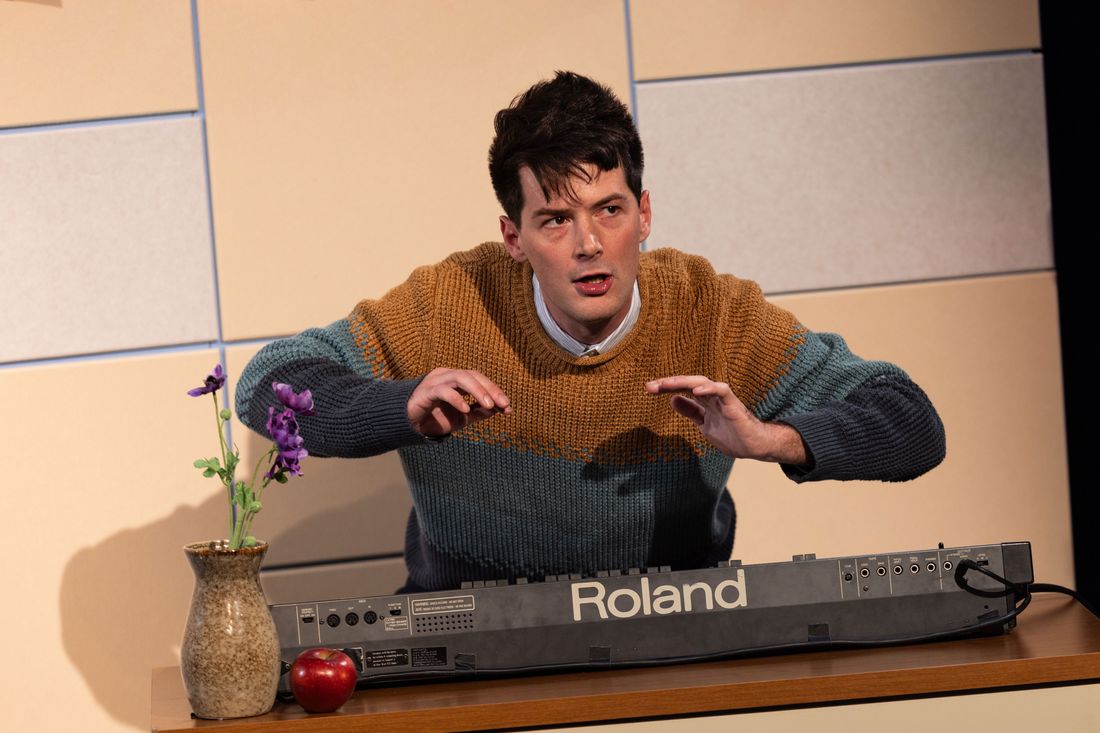
As far as preshow reception spreads go, this one exceeds expectations. There’s not only your standard “cheese plate with grapes and two kinds of melon” fare but a variety of hot options, plus wine. “That’s the teacher swag we need, that’s it right there,” says Malvia Rowe, a math teacher at Montauk Junior High School in Borough Park, Brooklyn. It is early in the evening, and she is clearly the hype person in her swishy baby-pink dress and sneaker slides, holding her bedazzled iPhone. We are at Educators’ Night for Milo Cramer’s one-man musical School Pictures — a by-invitation cocktail party and performance for 50 students, teachers, tutors, and administrators held in a scuffed-up rehearsal space–party room on the fifth floor of the building housing Playwrights Horizons, downstairs from the theater itself. (Rowe is also a ringer — she’s married to Playwrights’ audience-services manager, Katasha Nelson.) Rowe has brought in a bunch of her former students, plus her brother, Kyonne Rowe, an assistant principal at the Ascend Charter School in Brooklyn. (Clearly, Nelson understood the “Educators’ Night” assignment.)
The show we’re pregaming for is about Cramer’s experience as a tutor, prepping a wide range of local kids for the byzantine and competitive high-school admissions process and the all-important Specialized High School Admissions Test, a.k.a. the SHSAT. It’s the standardized exam given in eighth grade for admission to the city’s eight elite public schools, most notably the three giants (Stuyvesant, Brooklyn Tech, and Bronx High School of Science) that have produced Nobel Prize winners by double handfuls. Eighteen percent of kids get offered a seat, a Wonka golden ticket if you can’t or won’t pay for private school. (At the most competitive one, Stuyvesant High School, the offer rate is 3 percent, lower than Yale’s.) Then there’s a separate set of selective high schools beyond those eight, with byzantine admissions processes of their own: essays, interviews, auditions for the music and performing-arts schools. If you are a New York City student or parent, this whole business will at some point haunt your dreams.
Most of the students at the show tonight are in high school or college, mercifully past that horror, and have happily gathered for the evening, pausing at Playwrights’ step-and-repeat that a guy in a red jacket is taking full advantage of. Malvia Rowe steers me over to two teenagers chatting over the free food. Yo Yo goes to Millennium Brooklyn; Angela goes to Brooklyn Tech. They’re both 16 and very happy that the high-school test stress is behind them. Yo Yo didn’t actually take the test at all because it was during the pandemic, and you had to take it in person, and her parents didn’t want her to. Angela started test prep for the SHSAT in fifth grade. “It was kind of high-stakes since everybody kind of puts a lot of pressure on you,” she says. “Everybody’s working really hard to get into these, like, really good schools. So I just felt pressure.” Prep included extra homework, mock exams, and frequent essay assignments, even though the test didn’t have an essay component.
“Honestly, I was debating not taking it because I didn’t really have an interest in specialized high schools,” says Angela. “But then people around me were just saying, like, just give it a shot, you know, there’s nothing you can lose. So I just went in, and I just took it.” I ask if her parents would have minded if she’d opted out. “I think they’d understand if I didn’t, but I just wanted to because they paid for my prep. So, like, that’s the least I can do.” Angela says that everyone is happy now. I let her and Yo Yo go back to their cheese.
I chat with Don, who at first gives me a different name, and when I ask about personal pronouns, says, “Um, any.” I respond, “I get to pick?” and receive a clarification: “It’s more off vibes.” Don is smart, passionate, and funny. They (I picked; vibes) did not get into their first-choice school. “I sobbed, like, very loudly, very dramatically,” Don tells me. Don had wanted to go to the Beacon School, which only admits about 3 percent of applicants, but ended up at Edward R. Murrow High School in Midwood. Don offers me a quick rundown of the application process that isn’t quick at all: “You’re going to, like, tours for high school. Like, there’s different fairs. You have to interview at different places. Some places you have to take tests, auditions. You also have to study for the SHSAT, and also if you’re trying to apply to Catholic school, you took the TACHS [Test for Admission into Catholic High Schools], which was like basically just another standardized test. But yeah, it’s pretty cutthroat.”
I ask Don if it was worth the stress. “I mean, no. Nothing I was too worried about when I was younger was worth the stress.”
Charlie Nicholson, a tall ponytailed theater and English teacher from Gramercy School for the Arts, explains that students with audition coaching often have an edge at the performing-arts schools. “Definitely the students that had coaching are a little bit more connected to their monologue when they come into the audition room,” he tells me. I ask if that is an unfair advantage. “It’s a great professional, artistic, and personal experience to work with a coach, because it’s an opportunity to think about and interact with the art. But also as a teacher who’s involved in the audition process, I want to put together a program that would have students with different backgrounds and levels of experience.”
Nicholson offers up some hints for acing the audition process: The “rubric” looks at a student’s choices not only vocally but also in movement. “If a student is moving around the space, or has some kind of gesture or activity to go with their monologue, that’s interesting to see,” he says. “And if they’re making vocal choices that have a range of different sounds to it, that’s something that I could mark for the score.”
I wend my way back to Rowe, who introduces me to Bernice, a 16-year-old girl in a white surgical mask who had not been particularly interested in taking the test and had, in fact, fallen asleep during it. (She did finish it.) She’s currently at Science Skills Center in Downtown Brooklyn, her second choice, a selective school but not one of the elite eight. Kids get a second crack at the SHSAT in ninth grade, so Bernice says she’d like to try it again and maybe switch schools. “I’m kind of disappointed in myself,” she says. I ask if she’ll make sure to get a good night’s sleep next time. “I’ll just do my best. I think that’s good,” she answers.
Rowe points out, discreetly, that sometimes “there’s a disconnect” between “the level of the test and the level of the child.” The test is rigorous, she says, but “we never want to discourage anybody from giving something a try.” It is also only available in English. Kids can receive testing accommodations, including extra time, for special needs. And, of course, there’s an imbalance among kids who have test prep and tutoring and those who don’t. She can spot the prepped kids a mile away. ”While I’m teaching things in class, they’ve already learned it from their tutor,” she says. “And I have others who have no idea what I’m teaching in class. They’re completely struggling, but they’re mentioning topics at higher levels, because they’ve been going to tutoring. And they’re like, but when are we going to do slope? And I’m like, that’s not even in our content.” (I only very vaguely recall “slope” and feel certain that I could not pass this test today.)
I spot a group of students from SUNY Purchase. Their teacher for the course Plays and Playgoing, Peggy Stafford, is a playwright and put two kids through the NYC high-school wringer. When I talk to her students, they call her “Peggy.” She does not recall the high-school process with particular fondness. “There’s just a great deal of competitive feeling. Like there’s only so many slots,” she says. I notice that Peggy’s students seem happy. They clump together for a group photo in front of the step-and-repeat and seem to be enjoying the reception. Some are old enough to drink, so that probably helps.
Nelson and Rowe start shepherding people upstairs to their seats. I walk next to Dariel, a 19-year-old from Peggy’s program with a ponytail and braces who previously attended the Gramercy Arts High School and is upbeat about his high-school process. After the show, though, he admits that it “hit home.” When I find out where he went to school, I introduce him to Charlie the ponytailed teacher, but they don’t know each other.
If there were ever an audience for School Pictures, this is it. Cramer has the students, tutors, and teachers rapt from basically their first sentence (“Charlotte is in seventh grade; she wants to be an actress”) and certainly from the fourth (“Charlotte has radical dramaturgical ideas”). The show is a series of sung vignettes inspired by students Cramer tutored (a little like “The Day Off” and “Lesson #8” from Sunday in the Park With George), each named on a title card behind the simple schoolroom set. Cramer sings, plays the ukulele, and plunks out some notes on a baby piano that in lesser hands could have seemed gimmicky but in theirs is not.
As they sing through various kids with their various dreams and roadblocks, I see parallels with the teens mingling over cheese and grapes at that reception. In the final vignette, Cramer despairs, “No, no, no!” when a talented math student declares that she wants to study theater, and pounds it out on the piano for emphasis. It’s a laugh line, but I am aware that the audience is stacked with Peggy’s Plays and Playgoing students, and by the way, what did Cramer end up doing with their life?
I speak to Cramer afterward. “I feel sometimes like theater education is a pyramid scheme,” they say. “It’s very, very, very, hard to make any money.” But, they add, theater is how they found friends and connection; theater is “the meaningful vessel of my life.”
After the show, I mill around among Peggy’s students to hear what they thought. Many of them didn’t go to high school in New York City (Julia with the blue hair, Rin who wants to be a journalist), and say it sounds intense. Those who did (Steven with the flower-embroidered jacket, Dariel with the braces and high ponytail) confirm that the play is authentic. Steven says he didn’t even take the test; he got to the city and was placed in a middle school and eventually made his way to a charter school in Washington Heights. “I also feel like there’s a lot of gifted and smart kids that aren’t labeled gifted or smart because of the areas that they grew up in,” he says.
Cramer briefly comes out, and the kids give them a round of applause. As they go back inside, one shouts after them, “Milo, you’re a real one!” They all are.




